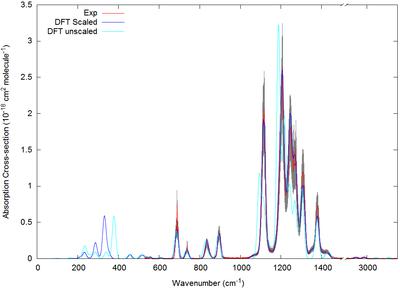Temperature-dependent absorption cross-sections are presented for five fluorinated molecules considered to be greenhouse gases due to being radiatively active in the mid-infrared. The molecules studied are perfluorotribulyamine (PFTBA), 2,2,3,3,3-pentafluoropropanol (PFPO), 1,1,1,3,3,3-hexafluoro-2-propanol (HFIP), perfluorodecalin (PFDC), and 2H,3H-perfluoropentane (HFC-43-10mee). HFIP is a fluorinated liquid commonly used as a specialty solvent for some polar polymers and in organic synthesis. PFTBA, PFPO, and HFC-43-10mee are commonly used in electronic and industrial applications. PFDC is capable of dissolving large quantities of gases, making it useful for a variety of medical applications.
Experimental absorption cross-sections were derived from Fourier transform infrared spectra recorded from 530 to 3400 cm$^{-1}$ with a resolution of 0.1 cm$^{-1}$ over a temperature range of 298 to 360 K. These results were compared to theoretical density functional theory (DFT) calculations and previously published experimental measurements made at room temperature.
Theoretical DFT calculations were performed using the B3LYP method and a minimum basis set of 6-311+G(2d,p). The calculations have determined the optimized geometrical configuration, infrared intensities, and wavenumbers of the harmonic frequencies for different ground-state configurations due to the presence of internal rotors. As the population of each configuration changes with temperature, changes in the experimental spectra were used to make accurate band assignments. From these band assignments, the DFT spectra were calibrated to match the experimental spectra, increasing the accuracy of the DFT prediction outside of the experimental range.
Using the adjusted DFT-calculated spectra, the wavenumber range was extended beyond the experimental range when calculating radiative efficiencies and global warming potentials. When using only the experimental range, the new values agreed with the previously published values. However, when the range was extended using the DFT spectra, the radiative efficiency and global warming potential were increased, suggesting that the current values are underestimating the climate impacts of these species.
Additionally, work done on building a long-path White type cell is presented. This new system can be used in the future to resolve weak lines to extract line parameters needed for atmospheric retrievals.
-

- DFT

